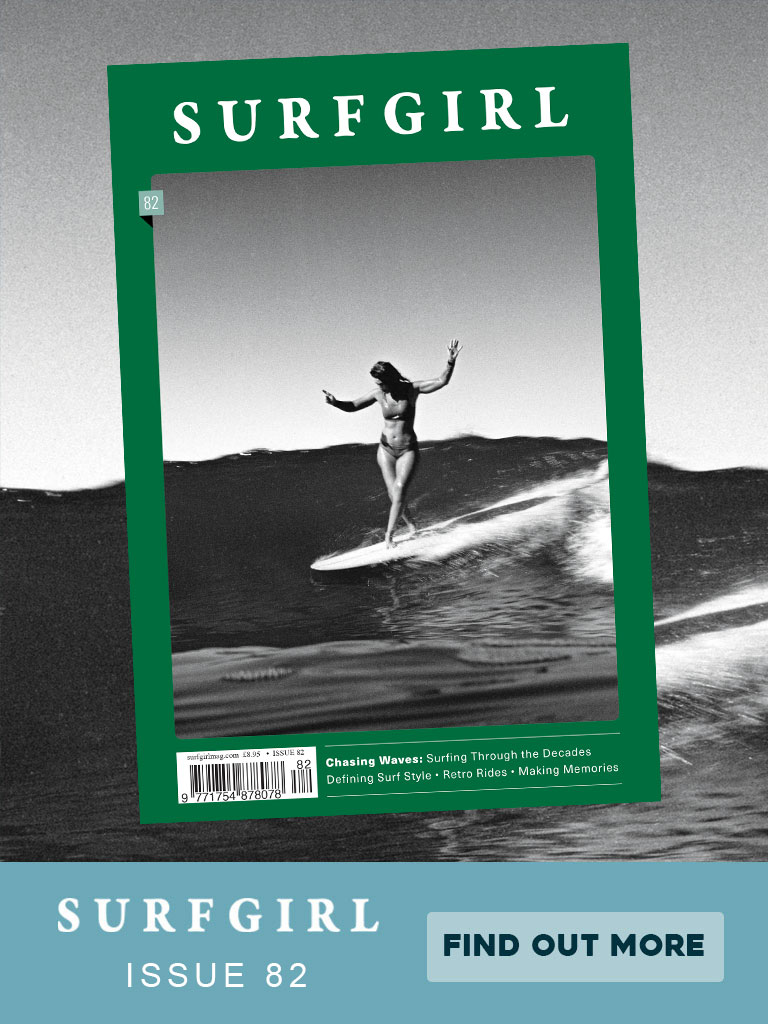
Why do we perceive some surfers to be better than others? And how do you become an accomplished surfer? Maybe it’s the guys and gals who surf at your local break the most, or maybe it’s the ones pushing the boundaries in performance. Whatever makes the best surfers, I want some of it!
I have been competing in the longboard circuit for a year now, and thanks to my amazing sponsors and my dad – who coaches me – I plan to compete for as long as I can. But I have so much to learn. With the more competitive life that we now lead it’s sometimes hard to remember the reasons why we surf. It’s not to outdo your fellow surfer, it’s not to win and it’s not about who surfed the biggest wave of the day. For me, surfing clears my soul and mind, makes me smile and recharges me to go back to ‘real-life’.
I know my strengths and during every surf I focus on fine-tuning them to improve. I also know my weaknesses, all too well. Obviously, surfing bigger waves holds more risk and therefore more skill and confidence is needed – and the prize is the increased thrill. However, some of my most thrilling surfs have been in low risk surf where I can push my limits because I don’t care if I fall off when I know the white water punishment won’t be too heavy. Yep, you guessed it, my weakness is size of the wave.
My dad Keith doesn’t understand, because according to him I surf to a high standard. But I’m pretty petrified if sets are coming in overhead. I can recall so many times I’ve sat on the beach in tears and watched what I think are massive waves come in, even though I have surfed the same size waves comfortably in the past. I try to blame it on becoming a parent and having a stronger survival instinct, but in reality my bravery levels have always been pretty low.
I’ve been lucky enough to surf some of the best surf spots around the world: I’ve lived in the Mentawais for a year, undertaken numerous visits to South Africa, been to Bali and surfed plenty of European treasures. Reef breaks are my heaven; on a longboard it gives me an element of safety to escape to the channel or ‘safety-zone’.
On the other hand, the beach breaks of the UK are hard work and intimidating in bigger surf, and I think this is where my fear has grown from. Trying to paddle out through head-high breakers at Fistral on my dad’s 9’6” log as a young teenager was one of the steepest learning curves I’ve experienced. It also taught me bad habits. I survive through big sets and do what I must to get to the safety of ‘out-back’, where I calm down enough to catch a wave.


Don’t get me wrong, there have been days where it’s been so far out of my comfort zone I have jumped off the rocks at South Fistral and literally only caught one wave – my wave in! I try to feel positive about that one wave, but in reality I feel like a let down. It’s not like I’m just a little worried out there – I’m scared! Sometimes, if it’s much bigger than I’m used to, I almost reach a panic attack state. I literally don’t think I’ll make it.
Inevitably though, I always make it. Yes, I may get pummelled in the white water but I always come up to the surface gasping and reaching for my board and make a split second fight or flight decision… turn around and belly ride to shore, tail between my legs ready to cry in my van, or toughen up and paddle with all my strength to make it out back in search of that confirmation that I am not a massive wimp!

However, when I am in a situation where the waves are chunky and I have to deal with a large amount of white water, or a deep duck dive into shallow reef, I always do just fine. In the moment of action, I succeed. It’s only after the event or the anticipation of something going wrong that messes with my head. It’s known as the ‘fear of the fear’.
So I started to take little steps to overcome my fear and started going in the surf at every available opportunity. Competing helped, as you have no choice but to surf when your heat is called. I then stayed in Jeffrey’s Bay in South Africa for 10 weeks earlier this year and my mindset change within weeks. I would have been on edge surfing my local breaks in overhead surf, but on the perfect right-hander point break there I was looking for the big waves in each set. The thrill of catching a wave with enough power and height to allow you to perform much deeper carves and turns pushed me to push myself.
I still have my limits though. There was one day where the swell was due to pick up throughout the day and so my dad encouraged me to get in first light while it was ‘smaller’. Ha, it was huge! I paddled out somehow with dry hair (I’m a speed paddler when I’m scared) and caught a few well overhead waves. I was stoked. But then this one set came rolling through that was on its way to being double overhead. I started to get spooked. I could deal with surfing in a place with risks like sharks and gnarly reef, but big, nasty waves… no thanks! I wimped out and as each set got bigger and bigger I got more and more nudged out of my feeble comfort zone and bowed my head in shame whilst paddling furiously back to the beach during a lull. I was stoked to have surfed in it and been out in bigger waves, but still a tad disappointed in myself.
Yes, I believe the best surfer in the water is the happiest one. So if you are happy surfing in waist-high waves, then that’s awesome. But I now also realise that the bigger size does allow you to push your performance levels and you do soon learn to become accustomed to being in bigger waves. With every surf I’m learning, and whatever ability I reach I will be happy to have achieved what I have, having surfed great waves and teaching my two young ones the value of the ocean.
As well as being a committed surfer and mum to two children, Katie also runs her own sports massage business in Newquay, Cornwall. Get in contact with Katie through Kernow Sports Massage page on facebook or call 07973384110




